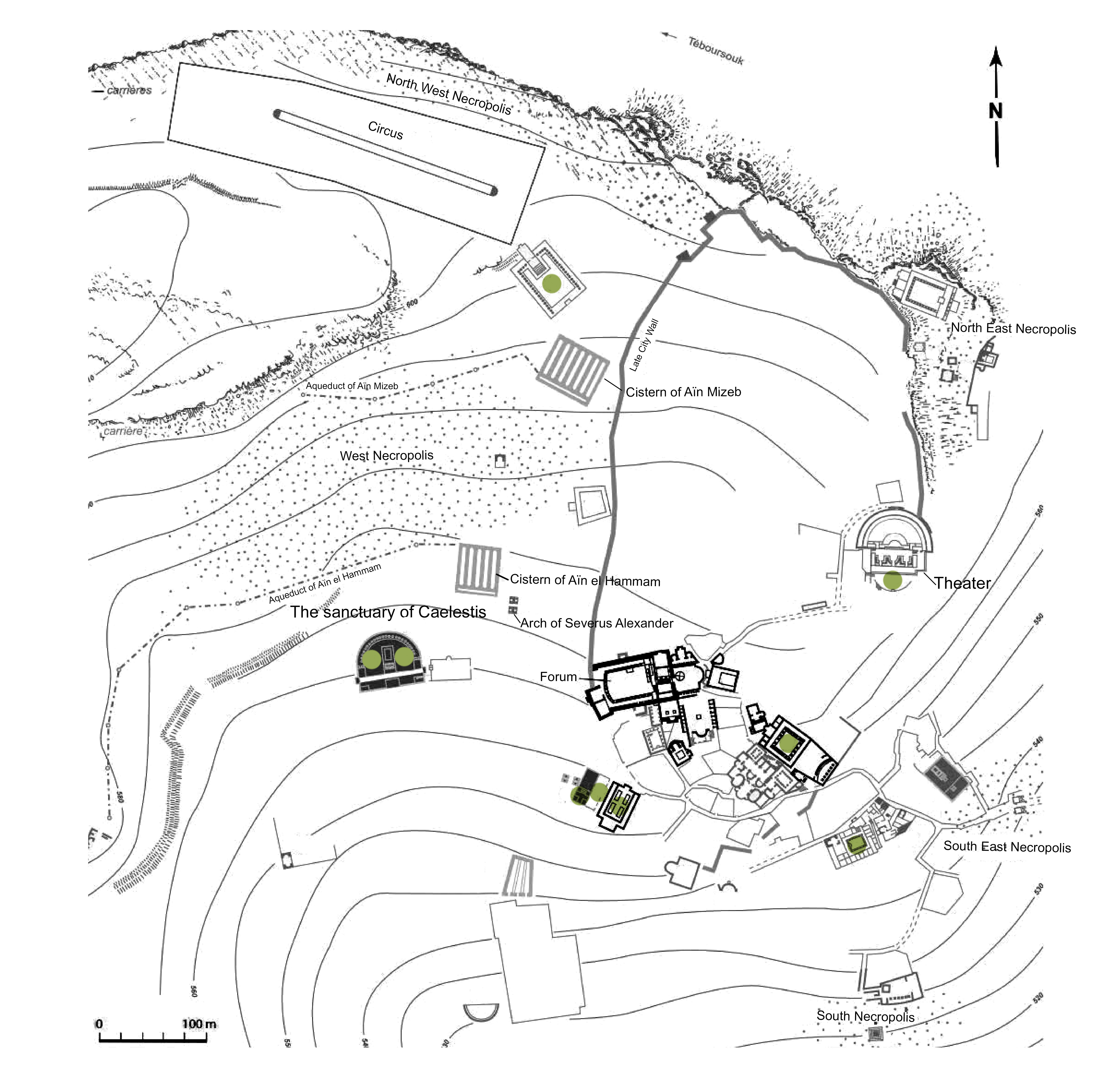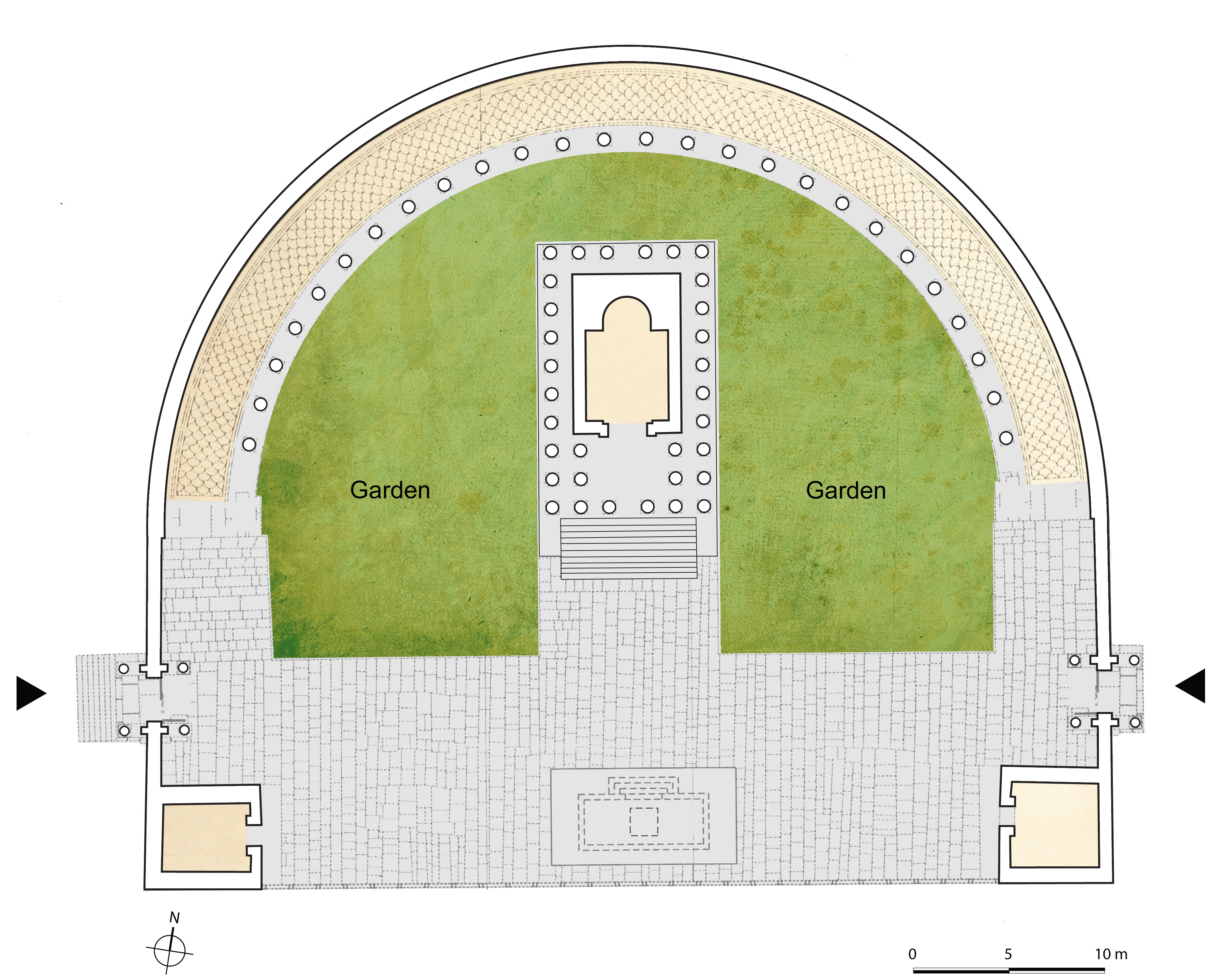The sanctuary of Caelestis
Province
Africa Proconsularis
Africa proconsularis (Pleiades)
Province Description
The history of Roman Africa begins in 146 BC with the destruction of Carthage and the establishment of the province of Africa in the most fertile part of the Carthaginian Empire. The new province covered about 5000 square miles (17,172 square kilometers) of the northern part of modern Tunisia. A praetor governed the area from his headquarters at Utica. The Romans inherited a thriving agriculture developed by the Carthaginians. The climate was hospitable. Wheat and barley were the most important cereals; wine and olive oil were also produced and there were various fruit trees.
Location
THUGGA (Dougga) Tunisia
THUGGA (Dougga) Tunisia (Pleiades)

Plan of Thugga (Maurin, L., d’après le relevé général de Cl. Poinssot, Les ruines de Dougga, 1959, pl. h. t.)
Location Description
Annexed in 46 B.C., the Romanization of the city of Thugga that was probably a residence of the Numidian kings, was gradual but profound. It became Municipium Thuggense in 205, and was raised to the rank of a Colonia Licinia Septima Aurelia Alexandriana Thuggensesin in 261 under Gallien. Numerous buildings of this city overlooking the valley of the Ouadi Khaled, have been uncovered among them the Capitol dedicated to the Capitoline Triad in 166-67, the theater on the top of the plateau constructed under Antonius Pius, the Temple of Mercury, Fortune, Augustan Piety, Liber Pater, Concordia, Frugifer, Pluto, Saturn and the Temple of Caelestis which stands in the middle of a an olive grove. In the residential areas stands the Licinian Baths with their Palestrae and the Cyclops Baths and the Triumphal Arch of Septimus Severus set astride a street leading down the hill. Two building inscriptions (CIL VIII, 26606 and CIL VIII, 26607), dated to AD 166-169 mention a theater with a basilica, porticoes, and xystis.
Garden
The sanctuary of Caelestis
Keywords
Garden Description
The sanctuary of Caelestis, installed on the north-western outskirts of the city, was built on a sizeable plot of land allocated to it by its commissioner during the reign of Severus Alexander (222-235). This sanctuary is distinguished by its semi-circular shape. Its Corinthian temple, peripteral and hexastyle, rises in the center of the courtyard on a podium reached by a staircase of eleven steps. A wide paved esplanade which spreads out in front of the temple. The complex is united by a central axis, which runs through the esplanade, to the staircase, through the entrances to the temple, whose altar was probably installed on this alignment. The remaining space of the unpaved courtyard was probably planted. This peripteral temple is reminiscent of the temple of Hephaestus on the Agora in Athens.
Maps
Plans

Fig. 1: Plan of the sanctuary of Caelestis (From Golvin, J.-C., Khanoussi, M. (dir.) 2005, p. 181, fig. 171])
Dates
222-235 CE
Bibliography
- Aounallah, S., Maurin, L., "Remarques sur la topographie rurale et urbaine du pagus et de la ciuitas de Thugga (Dougga, Tunisie)", in Hommes, cultures et paysages de l'Antiquité à la période moderne : Mélanges offerts à Jean Peyras, Rennes, Presses universitaires de Rennes, 2013. (worldcat)
- Golvin, J.-C., Khanoussi, M. (dir.), Dougga, études d’architecture religieuse. Les sanctuaires desVictoires de Caracalla, de « Pluton » et de Caelestis (Mémoires, 12), Bordeaux : Ausonius Éditions, 2005, pp. 99-182, fig.1, 21, 157, 171-172. (worldcat)
- Malek, A.-A., "Le jardin dans les sanctuaires du Maghreb romain, premières approches", in Du culte aux sanctuaires : l’architecture religieuse dans l’Afrique romaine et byzantine, Brouquier Reddé, V., Baratte, Fr., Rocca E. (dir.), Paris, de Boccard, coll. Orient et Méditerranée, 2018, pp. 213-230, p. 366, pl. 16. (worldcat)
Pleiades_ID
TGN ID
Contributor
Amina-Aïcha Malek (ORCID: 0000-0002-1628-615X)
Publication Date
21 Apr 2021